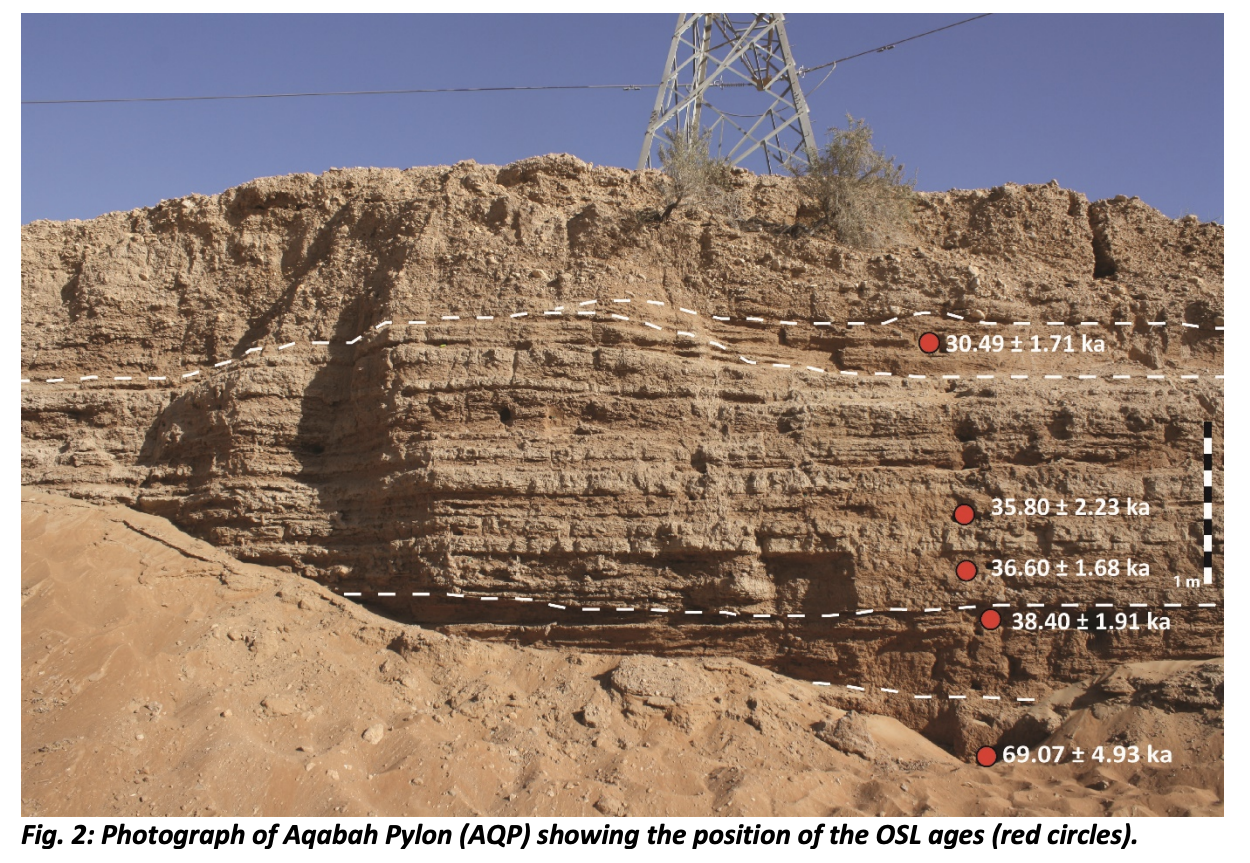The Arabian Peninsula is now recognised as an important geographical location with respect to early human demography (Parker, 2009; Armitage et al., 2011; Groucutt et al., 2015), with some researchers suggesting that periods of climatic amelioration facilitated important demographic shifts by creating conditions more conducive to seasonal range expansions (Rosenberg et al., 2011; Parton et al., 2013, 2015a). Despite this, there is notable spatial and temporal heterogeneity in Arabian palaeoclimatic records during the Late Pleistocene (Parton et al., 2015b), with evidence for climate change during certain key periods (e.g. Marine Isotope Stage 3) limited to just handful of spatially dispersed, terrestrial records. The development of new palaeoclimate records with good chronological control is crucial to addressing the current gaps in knowledge. This project aims to develop new independent, age-constrained, empirical data of Arabian climate change and subsequent landscape response from three stratified sequences along an unexplored ~30 km section in Wadi Iddayyah, UAE. The system is the main drainage feature within the Jebel Faya anticline, which has provided the earliest evidence of anatomically modern humans (Homo sapiens) identified in Arabia to date (~125 ka) (Armitage et al., 2011), and as such offers a unique opportunity for enhancing our understanding of climate-human demography in this marginal landscape. By comparing the new palaeoenvironmental evidence against the region’s archaeology, this study will investigate the proposed association between early human presence and periods of landscape transformation. The initial findings from three key sites identified along Wadi Iddayyah are reported here. This work forms part of the Co-Is PhD research which aims to systematically investigate the fluvial records of the region’s major wadi systems through time from source to sink.
The section of Wadi Iddayyah that is the focus of the current investigation is located in the Emirate Sharjah, UAE, on the eastern margin of the Arabian Peninsula (Fig. 1). The wadi originates at approximately 593 m above sea level on the Omani side of the Hajar mountains and has a catchment area of 2388.2 km2 . The main wadi channel passes to the west of Jebel Aqabah and Jebel Faya where the channel merges with its main feeder channel, Wadi Baraq (Parton et al., 2013). Together the two systems then run as a single stream channel in a north-west direction although the reduction in total flow volume is such that a defined channel is not maintained and terminates in the desert interior before reaching the Arabian Gulf coast. A 30 km stretch of Wadi Iddayyah was surveyed by the Co-I in March 2018, leading to the identification of three key sites: Aqabah Pylon (AQP), Wadi Iddayyah 1 (IDD1) and Wadi Iddayyah 2 (IDD2). Each section was cleaned and the sedimentary characteristics logged following standard techniques. A combined total of 55 samples were collected from the three sites for detailed sedimentological and geochemical laboratory investigation. In addition, 11 Optically Stimulated Luminescence (OSL) samples were retrieved from the three sites. The OSL dating work was undertaken at the University of Freiburg under the supervision of Prof. Frank Preusser. All ages are reported as preliminary results.
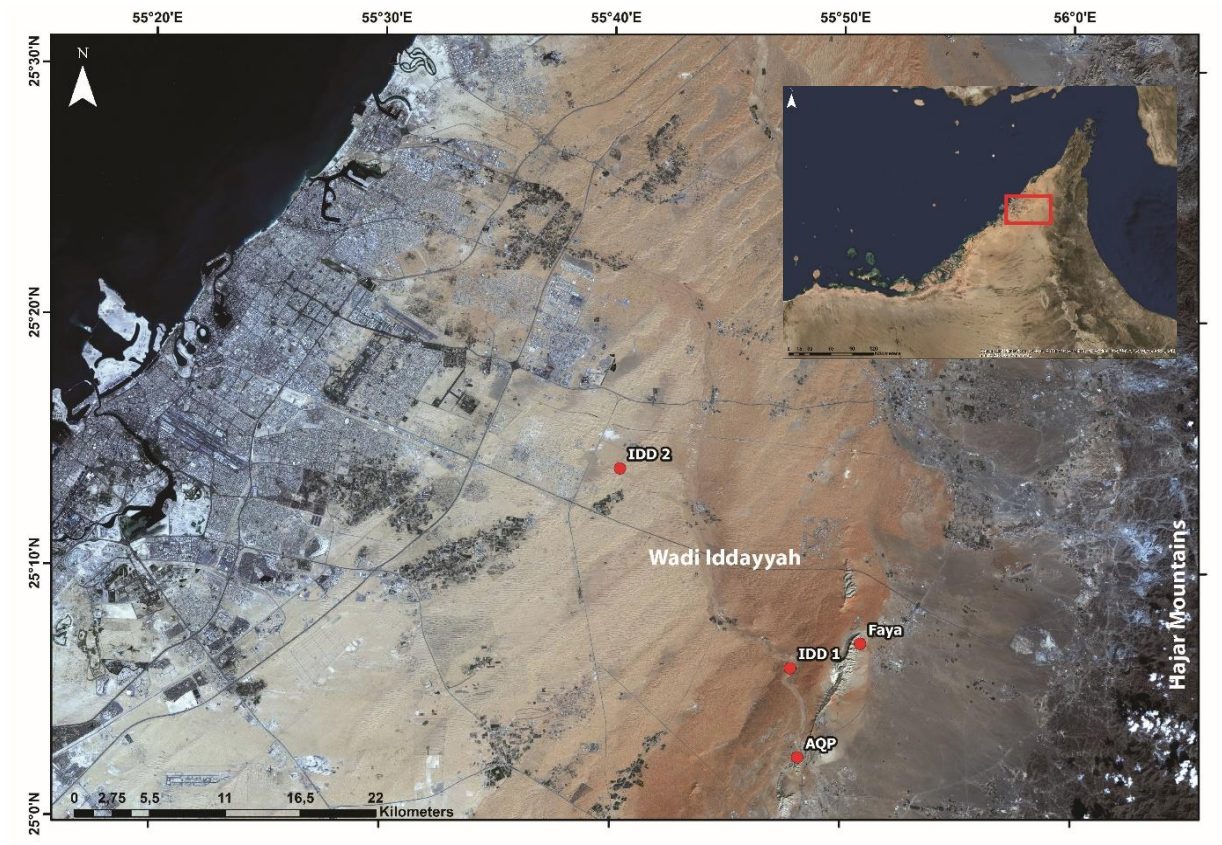
Fig. 1: Main image: Satellite image of the Wadi Iddayyah region showing the location of the study sites, AQP, IDD1 and IDD2, and Jebel Faya (Copernicus Sentinel-2 data 2017). Inset image: Satellite image of the northern UAE showing the location of Wadi Iddayyah (Esri Basemap 2018).
The 4.80 sedimentary sequence identified at AQP (N25°2.569′ E055°48.166′), which is located at the junction of Wadi Iddayyah and Wadi Baraq, is divided into three main stratigraphic units (Fig. 2). The basal unit (~0.40 m) is comprised of aeolian sands which are OSL dated to 69.07±4.93 ka. This age falls within MIS 4 (~75 – 60 ka), a period characterised by a general lack of dated terrestrial records (Parton et al., 2015b). Dune accumulation is recorded at Liwa, UAE (Stokes and Bray, 2005) and Wahiba, Oman (Preusser, 2009) during MIS 4, whilst at al-Sibetah, UAE the accumulation of aeolian sands (~2.00 m) is dated to 73.0±7.4 ka (Parton et al., 2015a). The deposition of aeolian sands at the base of the AQP sequence is consistent with the above evidence and supports to general consensus that hyper-arid conditions prevailed throughout much of MIS 4. The basal sands are overlain by ~4.00 m of (a) fluvially-deposited silts and planar-bedded sands interspersed with (b) minor carbonate-rich sand deposits containing desiccation polygon mud curls. Four OSL ages were obtained from this unit (from the base of the unit upwards): 38.40±1.91 ka, 36.60±1.68 ka, 35.80±2.23 ka and 30.49±1.71 ka. Whilst the four ages are in stratigraphic order (i.e. oldest at the base, youngest at the top), the error ranges of the basal three ages statistically overlap, potentially suggesting rapid deposition over a very short period. The sedimentological and geochemical data suggest that these deposits reflect repeated phases of channel flow which led to the reworking of aeolian sands by fluvial processes, with the deposits fining upwards suggesting a gradual waning of stream flow and desiccation. A broadly similar pattern of episodic stream flow is described by Parton et al. (2013) at a site approximately 1 km from AQP, where phases of overbank flooding/lake formation were dated between 61 – 58 ka. Evidence of early MIS 3 (~60.0 – 50.0 ka) drainage activation is also reported from central and south-eastern Arabia (Blechschmidt et al., 2009; McLaren et al., 2009; Parton et al., 2013, 2015a; Hoffmann et al., 2015). The OSL ages from AQP are therefore much later than most reported to date, falling towards the end of MIS 3 (~38.0 – 30.0 ka). Nonetheless it is noted that this period coincides with another insolation maxima (Berger and Loutre, 1991), potentially suggesting that strengthened monsoon rainfall was sufficient to trigger drainage activation and repeated phases of channel flow late in MIS 3. The upper ~1.20 m of the AQP section is comprised of moderately rounded limestone clasts within a fine-grained sand matrix and is undated. The origin and interpretation of this unit is still under investigation.
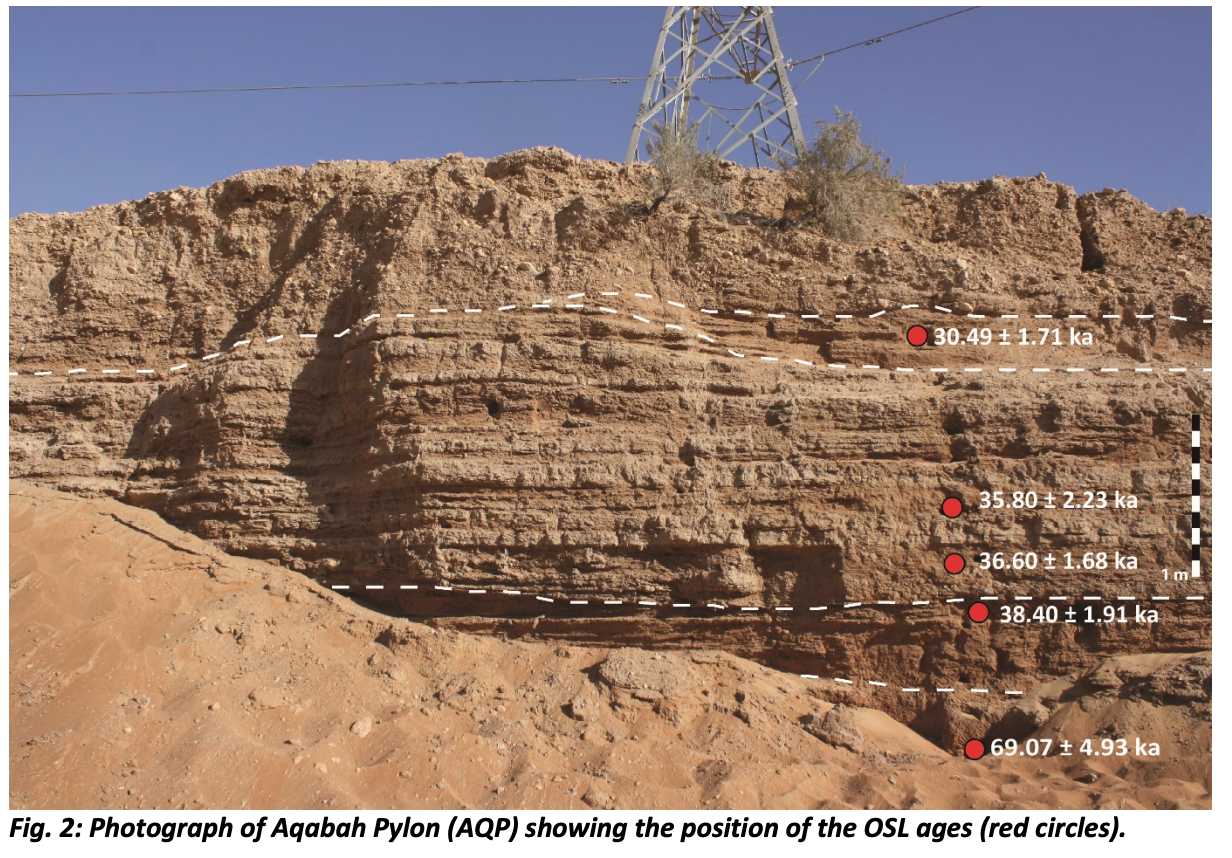
The 3.87 m sedimentary sequence at Wadi Iddayyah 1 (IDD1) (N25°6.135′ E 55°47.820′), which is located on the edge of the main wadi channel, comprises five main stratigraphic units (Fig. 3). The basal unit (~0.70 m) is comprised of aeolian sands which are OSL dated to 90.93±7.95 ka. This age falls within MIS 5.2 (~105 – 85 ka), a period of which relatively little is known about the prevailing climatic conditions (Parton et al. 2015b). In contrast to the distinct humid phases recorded during MIS 5.5, 5.3 and 5.1, the lack of speleothem growth during MIS 5.2 (Burns et al., 1998; Fleitmann et al., 2003) suggests a shift to more arid conditions. Evidence of aeolian activity is reported in Al Ain, UAE (Atkinson et al., 2013), Wahiba, Oman (Preusser, 2009) and Khujaymah, Saudi Arabia (Rosenberg et al., 2011). A reduction in monsoon rainfall/suppressed Inter Tropical Convergence Zone (ITCZ) over Arabia has been proposed at this time (Parton et al., 2015b) and it is noted that the period broadly corresponds to an insolation minimum (Berger and Loutre, 1991). The basal sands are overlain by a series of planar-bedded and cross-bedded sand deposits, the uppermost of which is dated to 33.30±3.18 ka, which are suggested to reflect the reworking of aeolian sands by late MIS 3 fluvial activity.
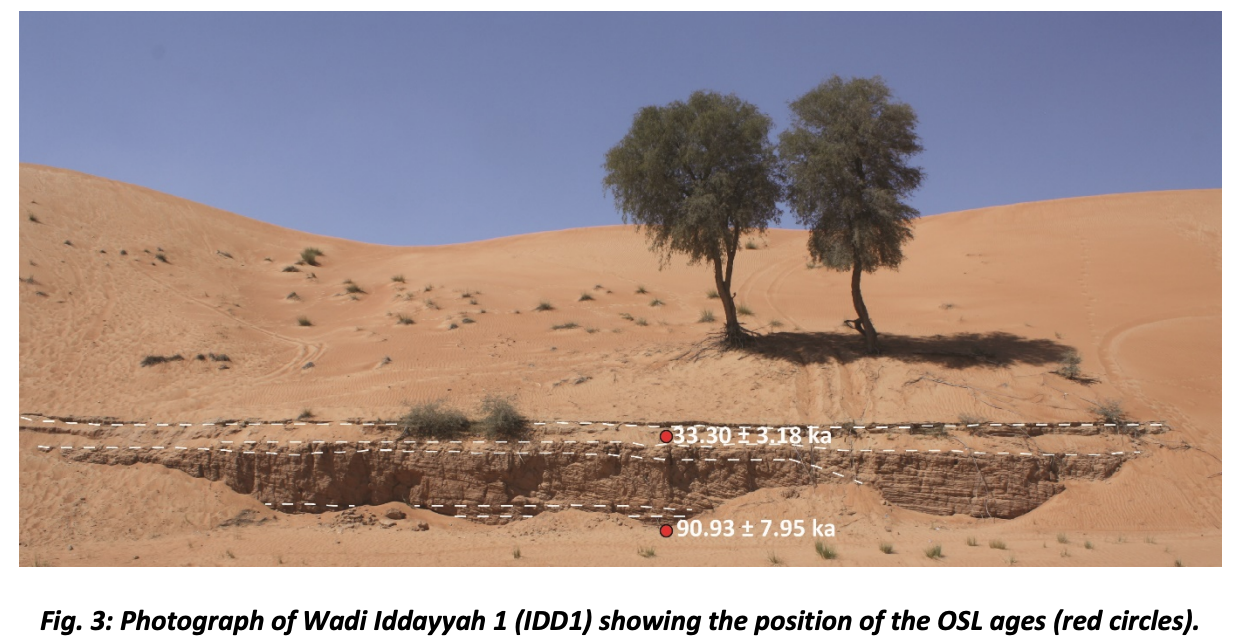
Wadi Iddayyah 2 (IDD2) (N25°14.039′ E55°40.343′), is a series of fluvial terraces which run along the right-hand side of a small channel which has punctuated through the dunes away from the main wadi channel (Fig. 4). At terrace A (0.45 m), the uppermost terrace, a ~0.10 m unit of silts is interspersed between aeolian sands indicating the development of a very low energy, fluvial environment. An OSL age of 15.42±0.91 ka was derived from the aeolian sands immediately beneath the silts. At terrace B (1.10 m) the basal unit comprises planarbedded, very fine sands which have a much higher silt component (~20%) than the upper units. An OSL age of 17.46±1.05 ka was derived from this unit. At terrace C two silt units are separated by aeolian sands dated to 16.10±0.91 ka. The uppermost sand unit at the site is OSL dated to 16.66±0.97 ka. The error ranges of the two ages statistically overlap potentially suggesting rapid, almost simultaneous, deposition. The accumulation of several distinct silt units at IDD2 implies that there was sufficient rainfall to generate low energy channel flow or standing water during MIS 2 (~30.0 – 11.50 ka). This is consistent with evidence from an increasing number of lake sites (Parker, 2009; Parker et al. unpubl.), travertines (Clark and Fontes, 1990), sabkha deposits (Wood and Imes, 1995) and speleothem records (Fleitmann et al., 2004) which highlight the probable occurrence of short-lived, wetter conditions during the otherwise hyper-arid conditions which are thought to have prevailed throughout much of MIS 2 (Leighton et al., 2014).
The deposition of aeolian sands at the base of the IDD1 and AQP sequences appears to postdate the oldest known occupation phase (assemblage C) at Jebel Faya which yielded OSL ages of 127±16, 123±10 and 94.8±13 ka (Armitage et al., 2011) although it is noted that the latter age does potentially fall within MIS 5.2. The next dated occupation phase at the site (assemblage A) yielded ages of 38.6±3.1 and 40.2±3.0 ka, thus falling in MIS 3 (~60 – 30 ka), and is separated from assemblages C and B by undated sterile sediments, possibly reflecting a break in occupation at the site between MIS 5.2 and MIS 3. The MIS 3 occupation layer at Jebel Faya is separated from a deposit containing early Holocene lithics (Fasad Points) by ~0.40 m of sterile sands which yielded ages of 38.6±3.2 and 34.1±2.8 ka (Armitage et al., 2011). These sterile sands are therefore broadly contemporaneous with the deposition of fluvial sediments at AQP, highlighting the complex interaction of aeolian and fluvial processes in the region. The implications of these findings in terms of human occupation and movement across the landscape is the focus of the Co-Is current PhD research and will be discussed in future papers.
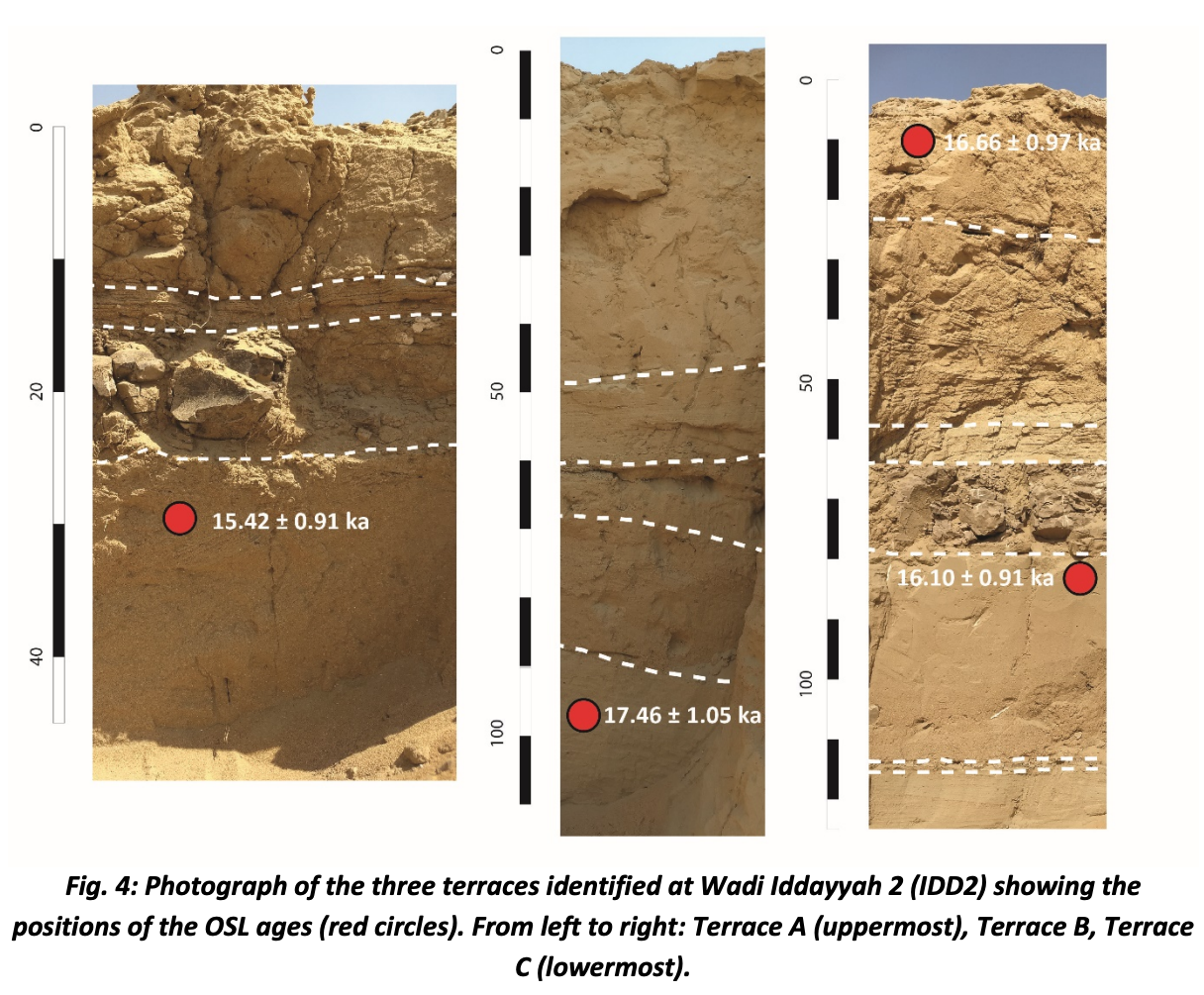
Acknowledgments:
The OSL dating and laboratory analyses were kindly supported by the International Association for the Study of Arabia (IASA). We would like to thank the Department of Culture and Information of the Emirate of Sharjah and the Directorate of Antiquities, for permission to work in the region, and especially Knut Bretzke for his support during the fieldwork. We are very grateful to Frank Preusser of the Sedimentary Geology and Quaternary Research group at the University of Freiburg and his team, including Daniela Mueller, Johannes Miocic and Alexander Fuelling, for their advice in the field and invaluable support during the OSL dating work. Finally, we are grateful to Adrian Parker and Ash Parton for their constructive comments throughout the course of this project.
References:
Armitage, S. J., Jasim, S. A., Marks, A. E., Parker, A. G., Usik, V. I., Uerpmann, H. P. (2011) The southern route “out of Africa”: evidence for an early expansion of modern humans into Arabia. Science 331, 453 – 456.
Atkinson, O. A. C., Thomas, D. S. G., Parker, A. G. and Goudie, A. S. (2013) Late Quaternary humidity and aridity dynamics in the northeast Rub’ al-Khali, United Arab Emirates: Implications for early human dispersal and occupation of eastern Arabia, Quaternary International, 300, 292 – 301.
Berger, A., Loutre, M.F. (1991) Insolation values for the climate of the last 10 million years. Quaternary Science Reviews 10 (4), 297 – 317.
Blechschmidt, I., Matter, A., Preusser, F., Rieke-Zapp, D. (2009) Monsoon triggered formation of Quaternary alluvial megafans in the interior of Oman. Geomorphology 110, 128 – 139.
Burns, S., Matter, A., Frank, N., Mangini, A. (1998) Speleothem-based paleoclimate record from northern Oman. Geology 26 (6), 499 – 502.
Clark, I., Fontes, J.C. (1990) Paleoclimatic reconstruction of northern Oman based on carbonates from hyperalkaline groundwaters. Quaternary Research 33, 320 – 36.
Fleitmann, D., Burns, S.J., Neff, U., Mangini, A., Matter, A. (2003) Changing moisture sources over the last 330,000 years in Northern Oman from fluid-inclusion evidence in speleothems. Quaternary Research 60 (2), 223 – 232.
Fleitmann, D., Matter, A., Pint, J.J., Al-Shanti, M.A. (2004) The Speleothem Record of Climate in Saudi Arabia. Open-File Report, Saudi Geological Survey, Jeddah, Kingdom of Saudi Arabia.
Groucutt, H.S., Petraglia, M.D., Bailey, G., Scerri, E.M.L., Parton, A., Clark-Balzan, L., Jennings, R.P., Lewis, L., Blinkhorn, J., Drake, N.A., Breeze, P.S., Inglis, R.H., Deves, M.H., Meredith-Williams, M., Boivin, N., Thomas, M.G., Scally, A. (2015) Rethinking the dispersal of Homo sapiens out of Africa. Evolutionary Anthropology 24 (4), 149 – 164. Hoffmann, G., Rupprechter, M., Rahn, M., Preusser, F. (2015) Fluvio-lacustrine deposits reveal precipitation pattern in SE Arabia during early MIS 3. Quaternary International 382, 145 – 153.
Leighton, C.L., Bailey, R.M., Thomas, D.S.G. (2014) Interpreting and modelling late Quaternary dune accumulation in the southern Arabian Peninsula. Quaternary Science Reviews 102, 1 – 13.
McLaren, S.J., Al-Juaidi, F., Bateman, M.D., Millington, A.C. (2008) First evidence for episodic flooding events in the arid interior of central Saudi Arabia over the last 60 ka. Journal of Quaternary Science 24, 198 – 207.
Parker, A.G. (2009) Pleistocene climate change in Arabia: Developing a framework for hominin dispersal over the last 350 ka. In: Petraglia, M.D., and Rose, J. (Eds.), The evolution of human populations in Arabia: Paleoenvironments, prehistory and genetics. Springer, Netherlands, 39 – 49.
Parker, A.G., Preston, G.W., Borgi,F. (Unpublished) Umm al-Qawain: Geomorphology and geoarchaeology report March 2014.
Parton, A., Farrant, A.R., Leng, M.J., Schwenninger, J.-L., Rose, J.I., Uerpmann, H.-P., Parker, A.G. (2013) An early MIS 3 pluvial phase in Southeast Arabia: Climatic and archaeological implications. Quaternary International 300, 62 – 74.
Parton, A., Farrant, A.R., Leng, M.J., Telfer, M.W., Groucutt, H.S., Petraglia, M.D., Parker, A.G. (2015a) Alluvial fan records from southeast Arabia reveal multiple windows for human dispersal, Geology 43 (4), 295 – 298.
Parton, A., White, T.S., Parker, A.G., Breeze, P.S., Jennings, R., Groucutt, H.S., Petraglia, M.D. (2015b) Orbital-scale climate variability in Arabia as a potential motor for human dispersals. Quaternary International 382, 82 – 97.
Preusser, F. (2009) Chronology of the impact of Quaternary climate change on continental environments in the Arabian Peninsula. Comptes Rendus Geoscience 341, 621 – 632.
Rosenberg, T.M., Preusser, F., Fleitmann D., Schwalb, A., Penkman., K., Schmid, T.W., AlShanti, M.A., Kadi, K., Matter, A. (2011) Humid periods in southern Arabia: Windows of opportunity for modern human dispersal. Geology 39 (12), 1115 – 1118.
Stokes, S., Bray, H.E. (2005) Late Pleistocene eolian history of the Liwa region, Arabian Peninsula. Geological Society of America Bulletin 117, 1466 – 1480.
Wood, W.W., Imes, J.L. (1995) How wet is wet? Precipitation constraints on late Quaternary climate in the southern Arabian peninsula. Journal of Hydrology 164, 263 – 268.

